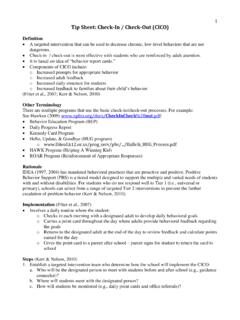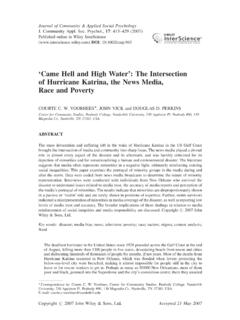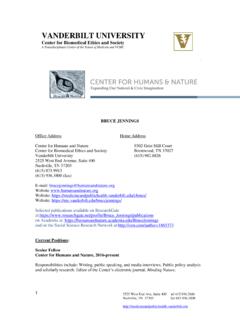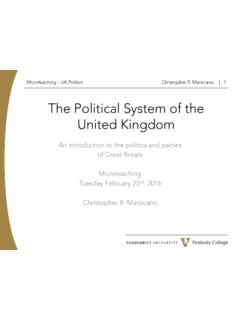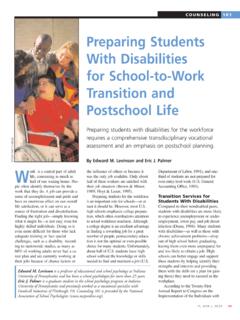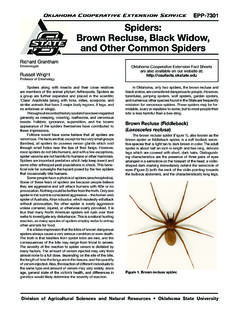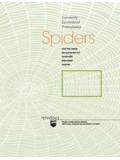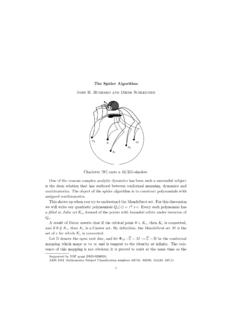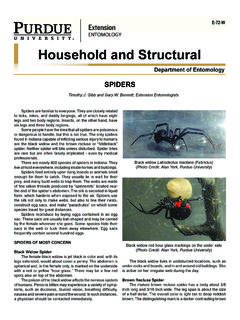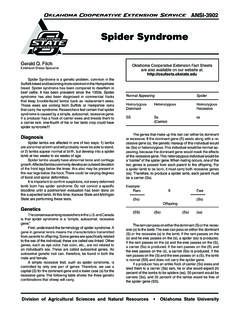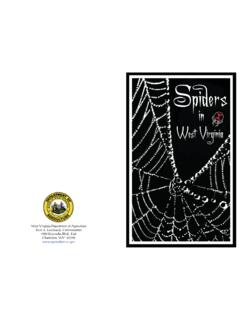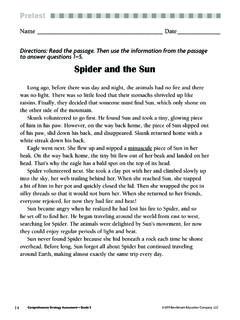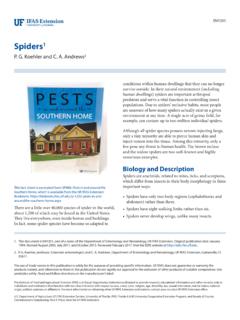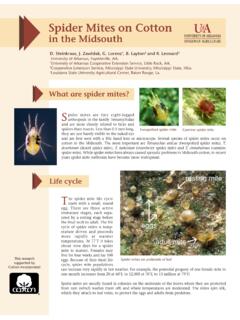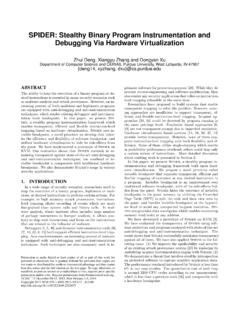Transcription of Development and Initial Validation of an Abbreviated ...
1 Development and Initial Validation of an Abbreviated spider PhobiaQuestionnaire using Item Response TheoryBunmi O. Olatunji,Vanderbilt UniversityCarol M. Woods,Washington University in St. LouisPeter J. de Jong,University of GroningenBethany A. Teachman,University of VirginiaCraig N. Sawchuk,University of WashingtonBieke David,Vanderbilt UniversityAn Abbreviated spider Phobia questionnaire (SPQ) wasdeveloped using methods based in item response of the 31 SPQ items that demonstrated good toexcellent discrimination along the spider fear continuumwere retained in Study 1 that consisted of 1,555 nonclinicaland clinical participants.
2 The SPQ-15 demonstrated goodinternal consistency and correlated highly with the full equation modeling revealed that the SPQ-15demonstrated excellent convergent validity, with strongassociations with small animal disgust and other phobicsymptoms. Supportive evidence was also found for diver-gent validity in relation to panic-related symptoms. TheSPQ-15 was uniquely predictive of avoidance behavior andfear and disgust responding towards spiders in nonclinical,analogue, and treatment-seeking samples in Studies 2, 3,and 4.
3 Lastly, in Study 5, the SPQ-15 was sensitive to theeffects of exposure-based treatment. These findings suggestthat the SPQ-15 has considerable strengths, includingdecreased assessment and scoring time while retaining highreliability, validity, and phobias ARE CHARACTERIZEDby an excessiveor unrealistic fear of specific objects or situations(American Psychiatric Association, 1994). Epide-miological studies have shown that an estimated 10to of people in the US experience a specificphobia in their lifetime (Kessler et al.)
4 , 2005; Magee,Eaton, Wittchen, McGonagle, & Kessler, 1996).Factor analytic investigations have consistentlyidentified animals as a distinct category of specificphobias (Arrindell, Pickersgill, Merckelbach, Ardon,& Cornet, 1991), with approximately 40% of alldiagnosed phobias belonging to this category (Chap-man, 1997). In fact, the most common specific fear inWestern societies is that of spiders, with prevalenceestimates upwards of 55% and 18% among femalesand males, respectively (Davey, 1992). Similar toother phobic disorders, individuals with spiderphobia experience persistent dread, immediatelyrespond with fear upon exposure, and generallyavoid situations in which the phobic stimulus mightbe encountered.
5 Despite evidence of role impairmentin phobia, only a minority of individuals with phobiaeverseek professional treatment (Magee etal.,1996).In contrast to many phobic disorders, disgustappears to play a prominent role in spider phobia(Olatunji & Deacon, 2008).Investigations of spider phobia have greatlyadvanced our clinical and theoretical knowledgeabout anxiety disorders. For instance, research onspider phobia has identified disgust as a criticalemotion that may be relevant for a variety of otheranxiety disorders (Olatunji & McKay, 2007).
6 Furthermore, the importance of context online at Therapy 40 (2009) 114 130 Address correspondence to Bunmi O. Olatunji, , Depart-ment of Psychology, Vanderbilt University, 301 Wilson Hall, 11121st Avenue South, Nashville, TN 37203; 0130$ 2008 Association for Behavioral and Cognitive Therapies. Published byElsevier Ltd. All rights fear extinction has been illuminated through theuse of samples with spider phobia (Vansteenwegenet al., 2007). Studies with spider phobia have alsohelped identify specific neural correlates of auto-nomic (amygdala) and direct evaluation (insula,anterior cingulate gyrus, left dorsomedial prefrontalcortex) of threatening stimuli (Straube, Mentzel, &Miltner, 2006).
7 Lastly, research employing spiderphobic samples has begun to shed light on the effectsof successful psychotherapy on brain function inpersons with anxiety disorders (Straube, Glauer,Dilger, Mentzel, & Miltner, 2006).The clinical condition of spider phobia appears toserve as a model for better understanding the pheno-menology of fear and anxiety in the the broad impact of research on spiderphobia, brief and sensitive methods of assessmentwould be of considerable utility. Although multipleself-report inventories exist, the spider PhobiaQuestionnaire (SPQ;Klorman, Hastings, Weerts,Melamed, & Lang, 1974) has established itself asthe most widely used measure of spider fear.
8 TheSPQ has been translated into several languages ( ,Dutch, Swedish) and has been adapted as a measurefor children (SPQ-C;Kindt, Brosschot, & Muris,1996). The SPQ was developed to assess the verbal-cognitive component of spider fear, consisting of 31true/false items, 9 of which are reversed-scored(Antony, Orsillo, & Roemer, 2001).Although the Development of the SPQ hasenabled researchers to follow a standardized pro-cedure for the evaluation of spider phobia (Klor-man et al., 1974), reports of the internal consistencyof the SPQ have been inconsistent.
9 For example,Muris and Merckelbach (1996)reported Chron-bach alpha of .62 before treatment and .90 aftertreatment for the SPQ in a sample of spider phobicindividuals. Muris and Merckelbach also found aCronbach alpha of .43 among nonphobic , other studies using the Kuder-Richard-son formula 20 have reported higher reliabilityestimates in nonclinical samples ( 's ranging to 90;Klorman et al., 1974). Despite variableinternal consistency estimates, the SPQ has demon-strated excellent test-retest reliability over periodsbetween 3 weeks (r=.)
10 94;Muris & Merckelbach,1996)and1year(r=.87;Fredriks on, 1983).Importantly, the SPQ discriminates individualswith spider phobia from those with snake phobiaand nonclinical controls (Fredrikson, 1983; Muris& Merckelbach, 1996) and correlates significantlywith other measures of spider fear and avoidance(Muris & Merckelbach, 1996). Lastly, the SPQ issensitive to the effects of treatment (Hellstrom & st, 1995; st, 1978; Teachman & Woody, 2003).Despite the widespread use of the SPQ and studiesexamining its psychometric properties, no study hasused modern statistical techniques, such as itemresponse theory (IRT; seeEmbretson & Reise,2000,orThissen & Wainer, 2001), to examine thepsychometric properties of each SPQ of analytic techniques, such as IRT,to the SPQ may be warranted given that the validityand relative utility of the measure is not withoutquestion (Packer, Bond, & Siddle, 1987).

